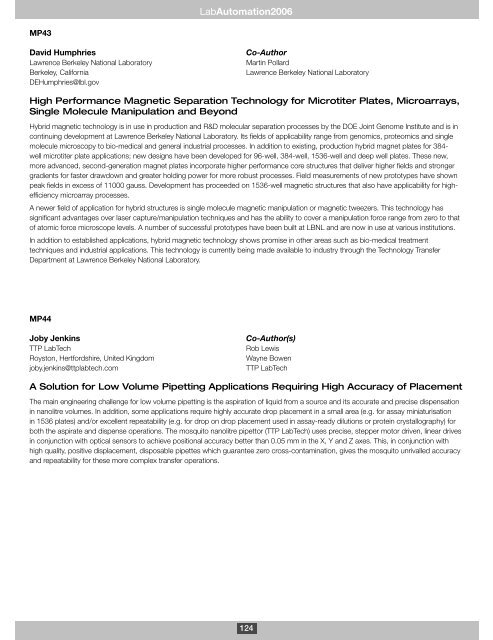LabAutomation 2006 - SLAS
LabAutomation 2006 - SLAS
LabAutomation 2006 - SLAS
Create successful ePaper yourself
Turn your PDF publications into a flip-book with our unique Google optimized e-Paper software.
MP43<br />
David Humphries<br />
Lawrence Berkeley National Laboratory<br />
Berkeley, California<br />
DEHumphries@lbl.gov<br />
<strong>LabAutomation</strong><strong>2006</strong><br />
Co-Author<br />
Martin Pollard<br />
Lawrence Berkeley National Laboratory<br />
High Performance Magnetic Separation Technology for Microtiter Plates, Microarrays,<br />
Single Molecule Manipulation and Beyond<br />
Hybrid magnetic technology is in use in production and R&D molecular separation processes by the DOE Joint Genome Institute and is in<br />
continuing development at Lawrence Berkeley National Laboratory. Its fields of applicability range from genomics, proteomics and single<br />
molecule microscopy to bio-medical and general industrial processes. In addition to existing, production hybrid magnet plates for 384well<br />
microtiter plate applications; new designs have been developed for 96-well, 384-well, 1536-well and deep well plates. These new,<br />
more advanced, second-generation magnet plates incorporate higher performance core structures that deliver higher fields and stronger<br />
gradients for faster drawdown and greater holding power for more robust processes. Field measurements of new prototypes have shown<br />
peak fields in excess of 11000 gauss. Development has proceeded on 1536-well magnetic structures that also have applicability for highefficiency<br />
microarray processes.<br />
A newer field of application for hybrid structures is single molecule magnetic manipulation or magnetic tweezers. This technology has<br />
significant advantages over laser capture/manipulation techniques and has the ability to cover a manipulation force range from zero to that<br />
of atomic force microscope levels. A number of successful prototypes have been built at LBNL and are now in use at various institutions.<br />
In addition to established applications, hybrid magnetic technology shows promise in other areas such as bio-medical treatment<br />
techniques and industrial applications. This technology is currently being made available to industry through the Technology Transfer<br />
Department at Lawrence Berkeley National Laboratory.<br />
MP44<br />
Joby Jenkins<br />
TTP LabTech<br />
Royston, Hertfordshire, United Kingdom<br />
joby.jenkins@ttplabtech.com<br />
Co-Author(s)<br />
Rob Lewis<br />
Wayne Bowen<br />
TTP LabTech<br />
A Solution for Low Volume Pipetting Applications Requiring High Accuracy of Placement<br />
The main engineering challenge for low volume pipetting is the aspiration of liquid from a source and its accurate and precise dispensation<br />
in nanolitre volumes. In addition, some applications require highly accurate drop placement in a small area (e.g. for assay miniaturisation<br />
in 1536 plates) and/or excellent repeatability (e.g. for drop on drop placement used in assay-ready dilutions or protein crystallography) for<br />
both the aspirate and dispense operations. The mosquito nanolitre pipettor (TTP LabTech) uses precise, stepper motor driven, linear drives<br />
in conjunction with optical sensors to achieve positional accuracy better than 0.05 mm in the X, Y and Z axes. This, in conjunction with<br />
high quality, positive displacement, disposable pipettes which guarantee zero cross-contamination, gives the mosquito unrivalled accuracy<br />
and repeatability for these more complex transfer operations.<br />
124
















